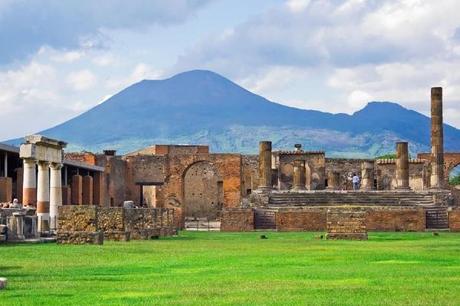
Mount Vesuvius is one of the most famous volcanoes in the world. Perched in the picturesque surroundings of the Bay of Naples in Italy, it is said to date back thousands and thousands of years. Since records began, it is thought to have erupted more than 50 times, but the pyroclastic flows that surged out of its peak in 79 AD were by far the worst (and most famous).
The eruption ended by blanketing the entire city of Pompeii and its neighbouring villages under a thick layer of volcanic ash which has preserved the ancient city right up until this day.
How Vesuvius Formed
Like any natural wonder, Vesuvius didn’t just appear overnight. Rather, it formed over hundreds of thousands of years and grew bigger with every eruption that took place. Since its beginning, it has had a fair number of violent eruptions, one of which dates as far back as 1780 BC. This particular eruption fired tons and tons of heated lava 22 miles into the sky and buried every single house within a 15-mile radius.
But despite its history of aggressively spewing molten lava across the Bay of Naples, many overlooked the “bad temper” of the volcano because the payoff was living in one of the most picturesque parts of Italy.
In 63 AD an earthquake struck the Campania region that, looking back, was clearly a sign that the disaster of 79 AD was on its way. But even within the 16 years between the two major events, people continued to flock to Naples and its shores.
What Happened When Vesuvius Erupted
August 79 AD is the setting for the most famous of Vesuvius’ eruptions. The volcano shot ashes, pumice, and other rocks into the air, with boiling hot volcanic gases following in hot pursuit. The residents of the Bay of Naples could see its outburst for hundreds of miles in every direction.
In fact, writer Pliny the Younger, who watched it unfold from across the bay, said that what appeared out the top of Vesuvius was a “cloud of unusual size and appearance” and likened it to a pine tree that “rose to a great height on a sort of trunk and then split off into branches”. Because of his words, disasters similar to Vesuvius are dubbed Plinean eruptions.
The scorching dust then poured down the volcano and into the ancient cities that surrounded its base and covered Pompeii and its neighbouring towns in a thick and deadly layer of blackness. More than two thousand people died in the eruption, and Pompeii was never to be lived in again.
Many years later when archaeologists began digging up Pompeii, they found the city remained pretty much intact underneath the layers of dust, which provided a fascinating and tragic insight into ancient Roman life and that fateful day back in August 79 AD.
How Vesuvius Formed
Like any natural wonder, Vesuvius didn’t just appear overnight. Rather, it formed over hundreds of thousands of years and grew bigger with every eruption that took place. Since its beginning, it has had a fair number of violent eruptions, one of which dates as far back as 1780 BC. This particular eruption fired tons and tons of heated lava 22 miles into the sky and buried every single house within a 15-mile radius.
But despite its history of aggressively spewing molten lava across the Bay of Naples, many overlooked the “bad temper” of the volcano because the payoff was living in one of the most picturesque parts of Italy.
In 63 AD an earthquake struck the Campania region that, looking back, was clearly a sign that the disaster of 79 AD was on its way. But even within the 16 years between the two major events, people continued to flock to Naples and its shores.
What Happened When Vesuvius Erupted
August 79 AD is the setting for the most famous of Vesuvius’ eruptions. The volcano shot ashes, pumice, and other rocks into the air, with boiling hot volcanic gases following in hot pursuit. The residents of the Bay of Naples could see its outburst for hundreds of miles in every direction.
In fact, writer Pliny the Younger, who watched it unfold from across the bay, said that what appeared out the top of Vesuvius was a “cloud of unusual size and appearance” and likened it to a pine tree that “rose to a great height on a sort of trunk and then split off into branches”. Because of his words, disasters similar to Vesuvius are dubbed Plinean eruptions.
The scorching dust then poured down the volcano and into the ancient cities that surrounded its base and covered Pompeii and its neighbouring towns in a thick and deadly layer of blackness. More than two thousand people died in the eruption, and Pompeii was never to be lived in again.
Many years later when archaeologists began digging up Pompeii, they found the city remained pretty much intact underneath the layers of dust, which provided a fascinating and tragic insight into ancient Roman life and that fateful day back in August 79 AD.
Advertisements
